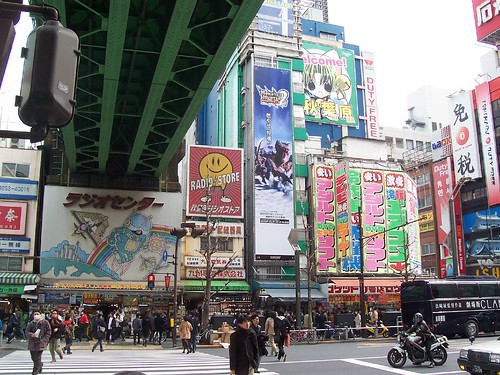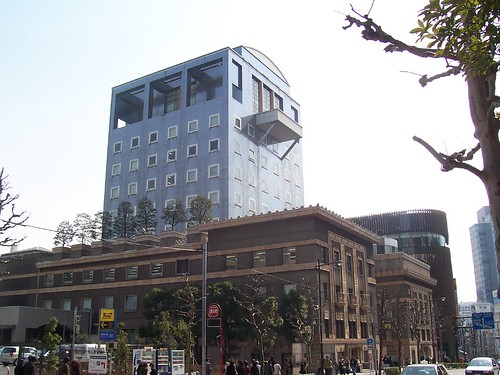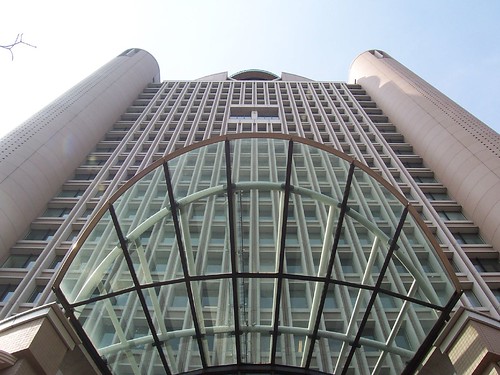Sensory saturation
I didn't manage the 5.30 start for the tuna auction, though it transpires that tourists can no longer view this early morning spectacle. The likelihood of me blagging my way in as a Japanese tuna salesman was minimal, so I decided against that plan. I was however out of the hotel before 7 and at the market in good time. Tsukiji market is the largest seafood market in the world and I recommend it as a must see for any food lovers, or for those simply interested in seeing this incredible spectacle. The market is on reclaimed land in Tokyo harbour and sees around 2 million kilos of fish pass through its doors every day.
The 900 or so wholesale dealerships are packed close together with just enough room to walk through the rows and enough space for speedy little trucks to dash through the columns, transporting large pallets of marine produce. After you've been struck by the efficient hustle and bustle, the people slicing frozen bodies of tuna with bandsaws and the incredible colours of fish around you, the smell, or near lack of seems quite remarkable. The fish is all so fresh that the only odour in the whole place is sweet and the similarity with what you'd call a fishy smell is almost non-existent.
I spent a good hour walking around the stalls, taking photos and marveling at the quantity and quality of what was around me. Rather than posting them all here individually I've linked to this Flickr set on the slideshow below. It really is an incredible place and certainly worth the early start.
However, the real treat is the fact that the restaurants dotted around the market receive the fish fresh each morning and serve what is simply the best sushi and sashimi in Tokyo, and therefore almost certainly the world. A sushi breakfast of the chef's recommended catches that day is not cheap - for me it set me back about two day's wages (total of 15 quid or a little under 30 dollars). However, to buy food of this quality anywhere else in Japan would be completely extortionate. Sushi for breakfast isn't my usual choice but walking round the market got my appetite into overdrive. The combination of ten pieces of sushi with a stunning fish soup were truly spectacular and, a day later I can still remember their flavours very distinctively; sweetness being the over-riding taste.
I sat and watched for a while after finishing this amazing meal as the chefs prepared breakfast for the other highly appreciative customers. It's a lot of fun to watch though I have to admit I don't really understand what the years of training perfect - perhaps that's the idea: they're so good that it just looks easy. (Incidentally, I have a sushi moral drama to explain/admit at some point soon.)
Anyway, leaving the restaurant I wandered the other shops surrounding the market which sell vegetables fresh from the market (which deals in flowers, fruit and vegetables as well as fish) and the stalls selling cooking equipment. I was extremely close to buying a knife and a whetstone but sadly they're just too expensive for now.

Walking around somewhat aimlessly, only vaguely attempting to find a metro station I found myself outside the Kabuki-za theatre and couldn't help but ask about the timing and prices for the day. Last year the only option was to see a full show which can take up a good few hours of the day and though I would have loved to do that again, economics once more won out. However, they now offer tickets for a single act of a play for a very reasonable price and so I went for this option. Sadly you cannot take videos or photos inside the performances but I've tracked down a couple of short clips on youtube. Kabuki is perhaps the most accessible of the classic forms of Japanese theatre with the costumes and movements being both exaggerated and beautiful. I find the music a lot more pleasant and often haunting than Beijing opera, which is also very beautiful visually but, for me, prohibitively cacophonous. These first two videos are of onnegata, the female characters played by male actors, which are some of the most incredible players in the troupe. See here, here and here where the shouts you hear are kakegoe from the audience showing their appreciation for the actors. The voice-over is very similar to that which you hear in your earpiece as you watch the performances live and, for me, is completely invaluable.
There are many different style of acting, which can be found within a single performance and the videos I've found show only a very limited number of techniques. Clearly seeing it for real is far more spectacular than seeing it on Youtube and a full day performance ranges from around £15 to around £80.
So, after a very enjoyable first scene from Yoshitsune Senbon Zakura I headed further North to Akihabara, the electronics district, hoping to be bowled over by the high-tech gadgets on display. Unfortunately, this gave me one of my first disappointments from Japan (not bad in two months). This area is the main retail district for computers, cameras, TVs and the like but though there's plenty of gaudy advertising, this is really a minitropolis of small shops packed with electronics, just as you would find in most modern cities. This is not the area where Sony, Phillips and Nikon show off their latest wears, this is simply for consumers, not for people wanting to play with the latest tech gadgets - I get the impression that Shinjuku is probably the area for more gadgedty tech displays.

I grabbed a quick walking lunch of Takoyaki and started strolling. It was a stunning, sunny day and I had nowhere in particular I needed to go so I started walking in roughly the direction of my hotel, the other side of the city. Five hours later I arrived back home, pretty exhausted but having taken in perhaps 15 km of the city including circling around the Imperial palace and seeing the blossom (though not cherry) that's in bloom at the moment:

seeing the interesting architecture around Nihon University:


passing by some in-city fishing.

and a lot more besides. (Each photo can be enlarged on the Flickr site).
Powered only by high quality fish I left myself completely exhausted by the end of the day. Taking the underground gives such a blinkered view of a city and spending a few hours getting thoroughly lost in areas that you weren't expecting to end up can be a wonderful way to see a good deal of the city. I advise getting lost whenever you have the liberty to do so, I tend to stick to this rule fairly religiously whether I want to or not. More of the pictures from the day can be found here.
Today, Sunday my mind is feeling refreshed enough to battle on with some problems I'm working on and hopefully a little more progress will be made in the few days I have left at Ochanomizu. Two months has flown by and though I'm having a great time here, it will be nice to get back home to Beijing.
No comments:
Post a Comment